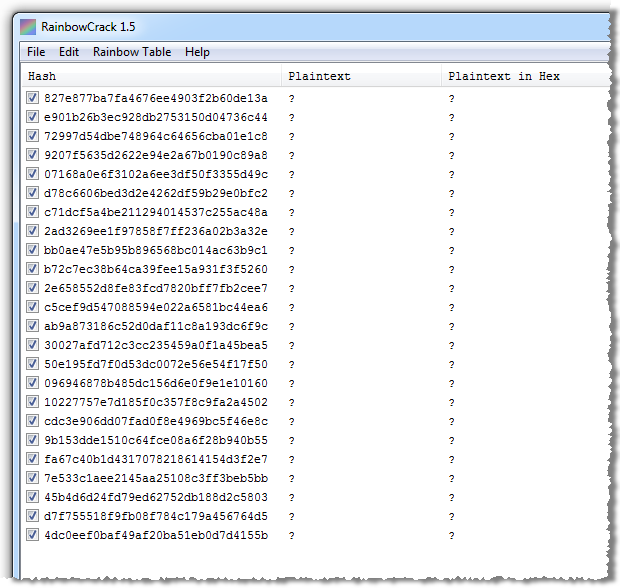

- HOW TO USE RAINBOWCRACK MD5 SUCCESSFULLY INSTALL
- HOW TO USE RAINBOWCRACK MD5 SUCCESSFULLY PRO
- HOW TO USE RAINBOWCRACK MD5 SUCCESSFULLY CODE
- HOW TO USE RAINBOWCRACK MD5 SUCCESSFULLY PASSWORD
I was debating whether to provide the following information/links or not. If one doesn't have mcrypt installed, then of course this is a pretty good class to use (but still needs the PEAR package to be installed). It is clear to me that using mcrypt has an overall significant speed performance gain than using the Blowfish.php class (with or without mcrypt installed). Below are the results.Īverage times using just mcrypt (not the new Blowfish.php class): So, of course I had to test the mcrypt by itself. It was interesting to see that with mcrypt installed the decryption time went considerably up (slower) while the encryption time was faster.
HOW TO USE RAINBOWCRACK MD5 SUCCESSFULLY PRO
I used my Windows XP Pro 3Ghz machine with PHP 5.0.4 under Apache 2, and the results are below.Īverage times using Blowfish.php class without mcrypt installed:Īverage times using Blowfish.php class with mcrypt installed: I used a simple key: 'A very secret key' and a small amount of text to encrypt: 'This is a test' I tested the class with and without mcrypt installed to see the difference in speed if any. I decided to quickly try some elementary speed tests on encrypting and decrypting with this new Blowfish.php class. It does work without it installed too, but if mcrypt is installed it uses that instead of it's own code. It actually looks to see if mcrypt is installed, and guess what? Yes, you guessed it! It uses mcrypt if it's installed. The heart of this script is a class inside Blowfish.php. It works and produces the same encrypted value as the one used by mcrypt (important thing to test).

I recently became aware of a PEAR script that can do a blowfish cipher without mcrypt. I think it's generally best to use mcrypt whenever possible and pick one of the many ciphers available. Here's some sample output from it: SAMPLE 1: It may not be the most secure but it's adequate, considering you can change the key and it uses an IV number.
HOW TO USE RAINBOWCRACK MD5 SUCCESSFULLY INSTALL
If you can't install the libmcrypt extension (or for open source not everyone will have mcrypt available), then you can use a home grown type of encryption and decryption routines. Use long keys and make sure you store the key off the web or public directory at your site (or recommend that if it's open source). I would use the libmcrypt extension instead. I don't recommend using it for passwords and other important or sensitive information. Let's say attacker has the hashed values of the passwords, and starts reading from the dictionary file and compares with the hashed values if matches then pasword is cracked, if salt is used then read from the dictionary and add some salt value then try to find a match.However this should be done for each user.Shawazi, as has been pointed out there isn't any particular MD5 decryption function, however, the MD5 hashes can be broken (not quickly or easily but it can be done).
HOW TO USE RAINBOWCRACK MD5 SUCCESSFULLY PASSWORD
The dictionary gets longer and also computational overhead and time gets longer for the attacker if she exploits the password file. So as The Rook mentioned, the passwords are stored by adding different salt values for each users. It is computationally infeasible to find any pear (x,y) such that
HOW TO USE RAINBOWCRACK MD5 SUCCESSFULLY CODE
If the hash function does not provide any of these properties, it does not matter how many times you hashed, also the attacker can hash n times to get the collisions.įor any given code h, it is computationally infeasible to findįor any given block x ,it is computationally infeasible to find y≠x However, if you want to really make brute forcing impossible, what you have to do is double the output-size (which can be compared to the key size in encryption).įirst not encryption creating Message Digest using the hash functions. This would be the same as increasing the output space to 129-bits. FOr instance, if you have 128-bits of output space for each algorithm, and it takes 1 hour to brute force, then it will take 2 hours to run the same brute force twice to get the original string. Running sha1(md5(text)) will only double the time it takes to find the original string. If either collides then the function overall collides and hence the result is (1/2^128) + (1/2^128) or 1/2^127 Then your chance of collision in the sha1 is 1/2^128. Your chance of collision in the md5 function is 1/2^128. Lets assume the sha1 function has a 128-bit output, and the md5 also has 128-bit output. If you run sha1(md5(text)) you first get the hash of md5, then pass that to sha1.

First is the likely-hood of a collision, and the second is the ability to run the algorithm on tons of values to find the original value which created the hash. You are talking about 2 distinct (although related) problems.


 0 kommentar(er)
0 kommentar(er)
